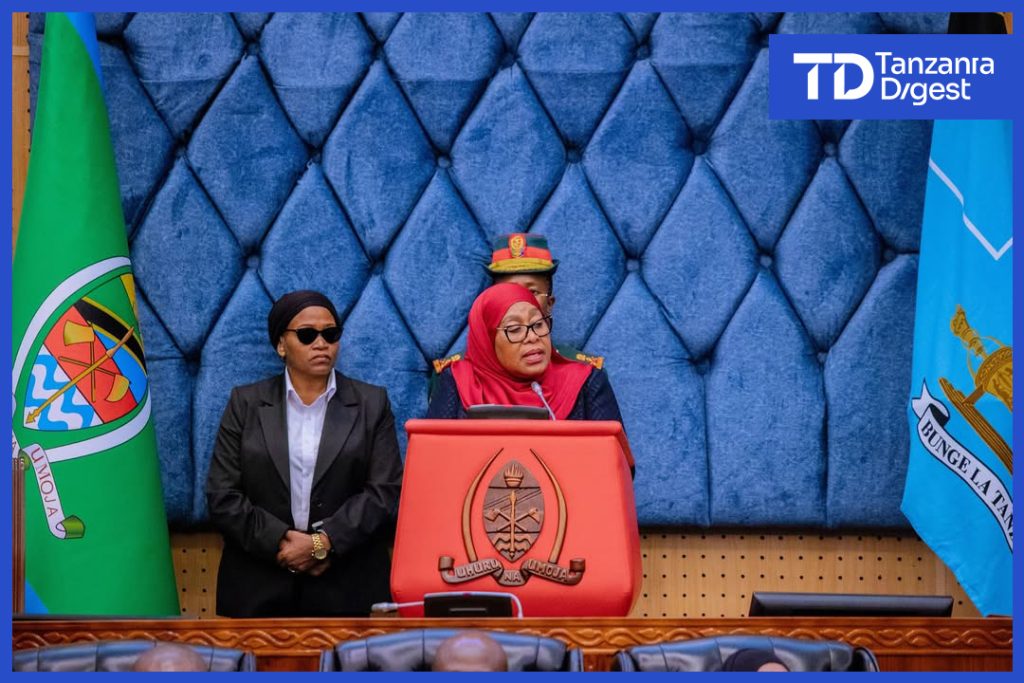The main themes of president Samia Suluhu Hassan were as follows:
Key Highlights from the Speech:
1. Directive on Disappearances:
President Samia ordered the police to intensify investigations into nationwide disappearances, calling it an “urgent matter” threatening public security. She demanded a shift from reactive to proactive policing.
2. Constitutional Reform Timeline:
She confirmed that the process of drafting a new constitution would begin during the 2025–2030 term, as outlined in the ruling party Chama Cha Mapinduzi (CCM) manifesto m.
3. Security and Economic Progress:
Samia praised Tanzania’s stability and commended defense/security forces. She also highlighted economic growth and debt management (noting a national debt of 107 trillion Tanzanian shillings).
4. Election Preparations:
The speech marked the dissolution of the 12th Parliament ahead of the October 2025 general elections. She noted subsidies of 87.87 billion shillings to political parties and amendments to electoral laws .
5. Parliamentary Recognition:
On June 1, 2025, Parliament honored her with an award for “exemplary leadership,” though this preceded the speech .
Detailed overview of her speech on security matters.
Here is a concise overview of President Samia Suluhu Hassan’s directive to investigate disappearances and key contextual details:
🔍 1. Presidential Directive on Disappearances.
– Urgent Security Threat:
On June 27, 2025, during the closing session of Tanzania’s 12th Parliament, President Samia Suluhu Hassan ordered police to intensify investigations into nationwide disappearances, calling them an “urgent matter” threatening public security.
– Proactive Policing Shift:
She demanded a move from reactive to proactive policing, stating, “I instruct the police force to step up efforts to end incidents of people disappearing”.
📊 2. Scale and Nature of Disappearances.
– Human Rights Data:
The Legal and Human Rights Centre (LHRC) documented “72 disappearances between 2020-2024”, with activists estimating “over 100 cases from 2021-2023”.
– Victim Profiles:
Cases involve entrepreneurs (e.g., five Kariakoo traders abducted in 2021), opposition figures (e.g., Chadema activists in 2024), and ordinary citizens. Families report abductors often impersonating police. Mdude was kidnapped from his home and in front of his family at night, and he is yet to be recovered. He was the most fierce critic of the CCM regime.
⚖️ 3. Police Response and Controversies.
– Official Stance:
Police Spokesperson David Misime claimed some disappearances were “self-staged” due to personal motives (debts, family disputes), citing cases like a Singida cleric who vanished to avoid debts.
– Criticism & Accountability Gaps:
Human rights groups note “Police investigations frequently stall”, with families receiving no updates. High-profile cases (e.g., opposition leader Ali Kibao’s 2024 murder) remain unresolved.
🏛️ 4. Broader Reforms and Election Context.
– Institutional Upgrades:
Samia highlighted investments in policing: “472 new stations”, “16,000 officers recruited”, and improved equipment.
– Election Timing:
The directive precedes Tanzania’s “October 2025 general elections”, where opposition groups cite disappearances as tools of political intimidation.
🌍 5. International Concerns.
– Transnational Repression:
Critics note cases like activist Maria Sarungi’s 2025 abduction in Nairobi, allegedly by Tanzanian agents, and the torture of Kenyan journalist Boniface Mwangi by Tanzanian security forces.
– UN Condemnation:
UN experts condemned Tanzania’s “200+ enforced disappearances since 2019”, urging accountability.
💡 Key Implications.
Samia’s order signals recognition of disappearances as a crisis, but its effectiveness hinges on addressing:
– Systemic Police Reform:
Ending impunity and ensuring independent oversight. No more erratic arrests without local leadership involvement.
– Political Will:
Translating directives into prosecutions, especially before elections.
Read more analysis by Rutashubanyuma Nestory

